| Sonnet 119 | |||||||
|---|---|---|---|---|---|---|---|
 Sonnet 119 in the 1609 Quarto | |||||||
| | |||||||
| |||||||
Sonnet 119 is one of 154 sonnets written by the English playwright and poet William Shakespeare. It's a member of the Fair Youth sequence, in which the poet expresses his love towards a young man.
| Sonnet 119 | |||||||
|---|---|---|---|---|---|---|---|
 Sonnet 119 in the 1609 Quarto | |||||||
| | |||||||
| |||||||
Sonnet 119 is one of 154 sonnets written by the English playwright and poet William Shakespeare. It's a member of the Fair Youth sequence, in which the poet expresses his love towards a young man.
Sonnet 119 is an English or Shakespearean sonnet. The English sonnet has three quatrains, followed by a final rhyming couplet. It follows the typical rhyme scheme of the form ABAB CDCD EFEF GG and is composed in iambic pentameter, a type of poetic metre based on five pairs of metrically weak/strong syllabic positions. The 3rd line exemplifies a regular iambic pentameter:
× /× / × / × / × / Applying fears to hopes and hopes to fears, (119.3)
An unusual number of lines (5, 6, 7, 8, 10, and 12) feature a final extrametrical syllable or feminine ending, as for example:
/ × × / / × × / × / (×) How have mine eyes out of their spheres been fitted, (119.7)
Line 7 (above) also features an initial reversal, and potentially a mid-line reversal. Other potential initial reversals occur in lines 6, 8, and 13, while potential mid-line reversals occur in lines 9 and 11.
The meter demands that line 6's "blessèd" is pronounced as two syllables. [2]
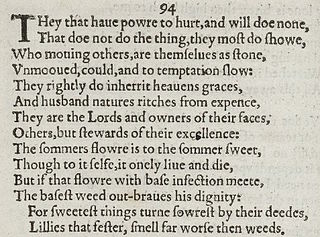
Sonnet 94 is one of 154 sonnets written by the English playwright and poet William Shakespeare. It is a member of the Fair Youth sequence, in which the poet expresses his love towards a young man.
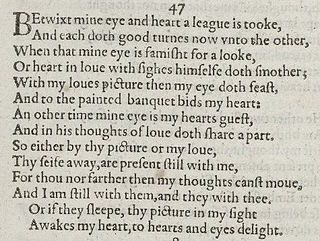
Shakespeare's Sonnet 47 is one of the Fair Youth sequence, addressed to a well-born young man. More locally, it is a thematic continuation of Sonnet 46.
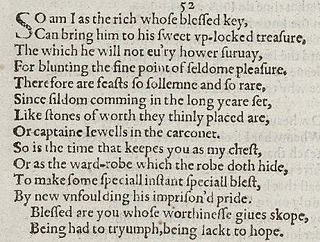
Sonnet 52 is one of 154 sonnets written by the English playwright and poet William Shakespeare. It is a member of the Fair Youth sequence, in which the poet expresses his love towards a young man.

Sonnet 61 is one of 154 sonnets written by the English playwright and poet William Shakespeare. It is a member of the Fair Youth sequence, in which the poet expresses his love towards a young man.

Sonnet 91 is one of 154 sonnets written by the English playwright and poet William Shakespeare. It's a member of the Fair Youth sequence, in which the poet expresses his love towards a young man.
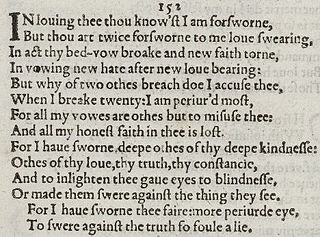
Sonnet 152 is a sonnet by William Shakespeare. It is one of a collection of 154 sonnets, dealing with themes such as the passage of time, love, beauty and mortality, first published in a 1609.
Sonnet 149 is one of 154 sonnets written by the English playwright and poet William Shakespeare.

Sonnet 142 is one of 154 sonnets written by the English playwright and poet William Shakespeare.

Sonnet 139 is one of 154 sonnets written by the English playwright and poet William Shakespeare.
Sonnet 137 is one of 154 sonnets written by the English playwright and poet William Shakespeare.

Sonnet 131 is a sonnet written by William Shakespeare and was first published in a 1609 quarto edition titled Shakespeare's sonnets. It is a part of the Dark Lady sequence, which are addressed to an unknown woman usually assumed to possess a dark complexion.

Sonnet 75 is one of 154 sonnets written by the English playwright and poet William Shakespeare. It is a member of the Fair Youth sequence, in which the poet expresses his love towards a young man.

Sonnet 90 is one of 154 sonnets written by the English playwright and poet William Shakespeare. It is a member of the Fair Youth sequence, in which the poet expresses his love towards a young man.
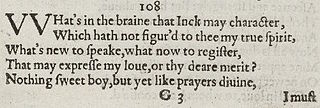
Sonnet 108 is one of 154 sonnets written by the English playwright and poet William Shakespeare. It is a member of the Fair Youth sequence, in which the poet expresses his love towards a young man.

Sonnet 111 is one of 154 sonnets written by the English playwright and poet William Shakespeare. It is a member of the Fair Youth sequence, in which the poet expresses his love towards a young man.
Sonnet 113 is one of 154 sonnets written by the English playwright and poet William Shakespeare. It's a member of the Fair Youth sequence, in which the poet expresses his love towards a young man.

Sonnet 114 is one of 154 sonnets written by the English playwright and poet William Shakespeare. It is a member of the Fair Youth sequence, in which the poet expresses his love towards a young man.

Sonnet 115 is one of 154 sonnets written by the English playwright and poet William Shakespeare. It is a member of the Fair Youth sequence, in which the poet expresses his love towards a young man.
Sonnet 120 is one of 154 sonnets written by the English playwright and poet William Shakespeare. It's a member of the Fair Youth sequence, in which the poet expresses his love towards a young man.

Sonnet 121 is one of 154 sonnets written by the English playwright and poet William Shakespeare. It is a member of the Fair Youth sequence, in which the poet expresses his love towards his young lover.